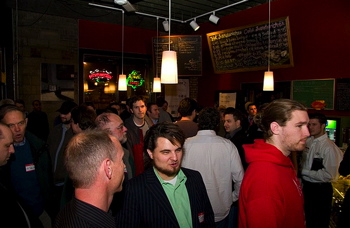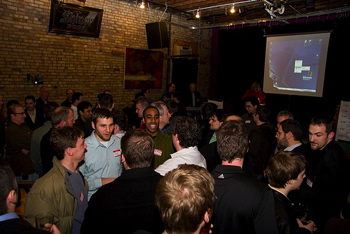So, the Wall Street Journal screams out this morning, on top of page B1, that ad targeting is coming to social networking site Facebook. See the article here (may require subscription). It seems, in order to justify the $10 billion valuation some of its investors are touting, they’re realizing that — oh, yes — we need to monetize this baby! Yeah, that’s right, before we go IPO…. 🙂  So, let’s start giving advertisers the ability to pinpoint their ads at just the specific individuals on Facebook, within certain very narrow demographics, that will most be interested in the product or service they’re advertising. Such, after all, is the Holy Grail of marketers everywhere. And, by golly, Facebook sure does seem to be a place where a glorious experiment like this could be carried out.
So, let’s start giving advertisers the ability to pinpoint their ads at just the specific individuals on Facebook, within certain very narrow demographics, that will most be interested in the product or service they’re advertising. Such, after all, is the Holy Grail of marketers everywhere. And, by golly, Facebook sure does seem to be a place where a glorious experiment like this could be carried out.
But, if Facebook needs more monetization of its service, think how much all the other, lesser social networks must, too. There are literally hundreds of thousands of these networks already set up, and more coming online every day. A typical site may only have a few thousand members. Ning alone will soon have 100,000 sites using their social networking platform. And an increasing number of firms offer such platforms for anyone to set up a social network, with basic levels of service that are free. See this recent TechCrunch post, which reviews several of them, and this accompanying chart that compares these offerings in great detail.
Sure, Facebook and MySpace, and a handful of other second-tier sites most people couldn’t name, account for a huge percentage of social networking web traffic today. But the long-tail of social networking sites promises to have traffic at least that big, collectively, ongoing. Have you ever stopped to think how these small players are supposed to monetize their sites? Meaning, get advertiser revenue that can support the cost of running a social network, paying for bandwidth, adding new features and original content, and so forth. The way things stand, there is little they can do now to pay for their sites. Some may be charging members for subscriptions, but that model is surely not one that can gain much traction.
Thus, I say longtail monetization via targeted advertising is the bigger story in social networking, with advertisers getting their ads (or sponsored editorial content) only to the specific demographics they want to reach, out in the long tail. Say, only males 20-30 interested in water sports, living in urban areas in the southest U.S. Perhaps a given ad would appear on hundreds or even thousands of sites, as opposed to a media buy that’s a huge swath of readers on just a single large site. So, for example, instead of buying exposure to 2 million people, the ad may only be seen by 200,000. But the idea is that ad performance will be much better because the audience is more interested in the ad, and more likely to act on it.
I think this latest news of Facebook starting the ball rolling with targeted social networking advertising is great. A large, innovative site like this should rightfully lead the way. But, with specialized ad targeting technology becoming available from new startups, I think it marks the beginning of what could be a much larger trend toward monetization of the entire social networking landscape. And I will surely be following this space very closely.
UPDATE (8/23): To add these links to the latest Hitwise social network rankings….for the U.S. and for the rest of the world.
2nd UPDATE (8/24): Online Media Daily posted a story this morning, by Gavin O’Malley, that attributes quite a statement to Forrester analyst Josh Bernoff — that Facebook’s ad targeting plan “could represent the most significant move in the world of online advertising since the advent of AdSense.”
 I know its painful for you purists out there (trust me, it hurts me, too), but I just can’t fit in my big camera at these things. I have to travel light. These will still give you a feel for things, I hope, here at
I know its painful for you purists out there (trust me, it hurts me, too), but I just can’t fit in my big camera at these things. I have to travel light. These will still give you a feel for things, I hope, here at  (Times getting tough, Eric? I know you’re trying to control that headcount now, but why is the party budget always the first to go?) I did hear WebTrends took some people to the Cubs-Phillies game, but that was about it. There were likely other, smaller gatherings, however — with 3000-some people at this thing. The majority of the attendees turned out for this one, big, official party, however (sponsored by CIMA) — so, it was mobbed. One free drink ticket and some minimal muchies — whoopie. But everyone seemed to be having fun, whether indoors in the AC, or out in the humid air on the crowded, narrow deck alongside the river.
(Times getting tough, Eric? I know you’re trying to control that headcount now, but why is the party budget always the first to go?) I did hear WebTrends took some people to the Cubs-Phillies game, but that was about it. There were likely other, smaller gatherings, however — with 3000-some people at this thing. The majority of the attendees turned out for this one, big, official party, however (sponsored by CIMA) — so, it was mobbed. One free drink ticket and some minimal muchies — whoopie. But everyone seemed to be having fun, whether indoors in the AC, or out in the humid air on the crowded, narrow deck alongside the river.  (How do I always manage to meet surfers at conferences? Global tribe, indeed…) He covers the Midwest, so had recently been in Mpls to meet with Target. He said he’s hearing advertisers wanting technology that would let web users pull widgets off their ads to put onto their own SN sites. Pretty cool. Also ran into Manoj Jasra, director of technology for B2B search firm Enquiro in British Columbia. He’s here blogging for his own blog and has a close relationship with WebTrends (but missed the bus to Wrigley Field).
(How do I always manage to meet surfers at conferences? Global tribe, indeed…) He covers the Midwest, so had recently been in Mpls to meet with Target. He said he’s hearing advertisers wanting technology that would let web users pull widgets off their ads to put onto their own SN sites. Pretty cool. Also ran into Manoj Jasra, director of technology for B2B search firm Enquiro in British Columbia. He’s here blogging for his own blog and has a close relationship with WebTrends (but missed the bus to Wrigley Field).
 But here goes, Farren: you asked what’s one cool thing we need in online advertising but don’t have yet? Okay, listening? It’s the ability to target brand messages to very specific, pinpointed demographics across all the social networking sites that are proliferating out there — thousands and thousands of them (not just the big ones everyone’s heard of). Think long tail, and because all those SN sites need to monetize to stay alive. That’s just got to happen, and I’m betting it will soon. So, there ya have it!
But here goes, Farren: you asked what’s one cool thing we need in online advertising but don’t have yet? Okay, listening? It’s the ability to target brand messages to very specific, pinpointed demographics across all the social networking sites that are proliferating out there — thousands and thousands of them (not just the big ones everyone’s heard of). Think long tail, and because all those SN sites need to monetize to stay alive. That’s just got to happen, and I’m betting it will soon. So, there ya have it! 





 on Monday afternoon, CEO Gilmour spoke of the ready market for Illumio: “There will be something like 50 million desktop search engines by the end of 2006, and there will be zero PCs without desktop search after the next OS generation.” He said his company’s Illumio technology now supports Google and MSN desktop search, and others will follow. It searches files, documents, email, contacts, favorites, browser cache, appointments, and more. He allowed, however, that a problem with desktop search is privacy. “The market is hyper-sensitive about that,” and he said his company works hard on it.
on Monday afternoon, CEO Gilmour spoke of the ready market for Illumio: “There will be something like 50 million desktop search engines by the end of 2006, and there will be zero PCs without desktop search after the next OS generation.” He said his company’s Illumio technology now supports Google and MSN desktop search, and others will follow. It searches files, documents, email, contacts, favorites, browser cache, appointments, and more. He allowed, however, that a problem with desktop search is privacy. “The market is hyper-sensitive about that,” and he said his company works hard on it. Zingee creates web links to all the files on your computer that you want it to. And you securely control exactly what is shared and who you share it with. There are no file size restrictionss, and viewers do not need to register or install anything. D.K. Kim has a background with Citibank and HP, and also was cofounder and CEO of financial services portal Quicken.com Austral-Asia, which had an IPO in 1999 on Australian Stock Exchange. Zingee is based in Singapore but also has people in Australia, including Sydney-based
Zingee creates web links to all the files on your computer that you want it to. And you securely control exactly what is shared and who you share it with. There are no file size restrictionss, and viewers do not need to register or install anything. D.K. Kim has a background with Citibank and HP, and also was cofounder and CEO of financial services portal Quicken.com Austral-Asia, which had an IPO in 1999 on Australian Stock Exchange. Zingee is based in Singapore but also has people in Australia, including Sydney-based  Mick Liubinskas, who is the company’s CMO. Mick, a surfer (that’s him in the photo), has sales and marketing experience with IBM, Virgin, and several IT startups. More recently, he headed global marketing and business development for Kazaa. I asked him about that experience: “I was hired as the first marketing person and grew the team to about ten and grew downloads to 300 million — the most downloads in history. Most of it was viral but we worked hard on media and partner marketing.”
Mick Liubinskas, who is the company’s CMO. Mick, a surfer (that’s him in the photo), has sales and marketing experience with IBM, Virgin, and several IT startups. More recently, he headed global marketing and business development for Kazaa. I asked him about that experience: “I was hired as the first marketing person and grew the team to about ten and grew downloads to 300 million — the most downloads in history. Most of it was viral but we worked hard on media and partner marketing.” A newer offering is Wiffiti™, which the company calls the first in-location blogging network — “facilitating freedom of expression on the street.” Randall said it’s about “web and phones converging, to the ‘Web Outside’.” It combines social networking with blogging for venues like bars, clubs, and restaurants. Wiffiti™ encourages people to interact with content or entertainment on large-format, Internet-connected screens via their mobile phones. The company says there are “massive untapped markets beyond the couch and the desk.” Out-of-home media is going digital in locations ranging from retailers to street corners, they say. What’s really unique about LocaModa’s proprietary interactive networks is that it “helps consumers in the moment to opt-in and connect to brands.” Consumers can use their mobile phone like a remote control to surf or communicate with large screens in storefront windows, cafes, bars, or city streets. The company “converts passive out-of-home networks into interactive marketing networks.” This was definitely one of the most different, unique applications of technology and Web 2.0 social networking at Demo 2006.
A newer offering is Wiffiti™, which the company calls the first in-location blogging network — “facilitating freedom of expression on the street.” Randall said it’s about “web and phones converging, to the ‘Web Outside’.” It combines social networking with blogging for venues like bars, clubs, and restaurants. Wiffiti™ encourages people to interact with content or entertainment on large-format, Internet-connected screens via their mobile phones. The company says there are “massive untapped markets beyond the couch and the desk.” Out-of-home media is going digital in locations ranging from retailers to street corners, they say. What’s really unique about LocaModa’s proprietary interactive networks is that it “helps consumers in the moment to opt-in and connect to brands.” Consumers can use their mobile phone like a remote control to surf or communicate with large screens in storefront windows, cafes, bars, or city streets. The company “converts passive out-of-home networks into interactive marketing networks.” This was definitely one of the most different, unique applications of technology and Web 2.0 social networking at Demo 2006.
Recent Comments